Locoweed is a common name in North America for any plant that produces swainsonine, a phytotoxin harmful to livestock. Worldwide, swainsonine is produced by a small number of species, most in three genera of the flowering plant family Fabaceae: Oxytropis and Astragalus in North America, and Swainsona in Australia. The term locoweed usually refers only to the North American species of Oxytropis and Astragalus, but this article includes the other species as well. Some references may list Datura stramonium as locoweed.

Astragalus is a large genus of over 3,000 species of herbs and small shrubs, belonging to the legume family Fabaceae and the subfamily Faboideae. It is the largest genus of plants in terms of described species. The genus is native to temperate regions of the Northern Hemisphere. Common names include milkvetch, locoweed and goat's-thorn. Some pale-flowered vetches are similar in appearance, but they are more vine-like than Astragalus.

Oxytropis campestris, the field locoweed, is a plant native to the Northwestern United States and all Canada, sometimes grown as an ornamental plant.

Swainsonine is an indolizidine alkaloid. It is a potent inhibitor of Golgi alpha-mannosidase II, an immunomodulator, and a potential chemotherapy drug. As a toxin in locoweed it also is a significant cause of economic losses in livestock industries, particularly in North America.
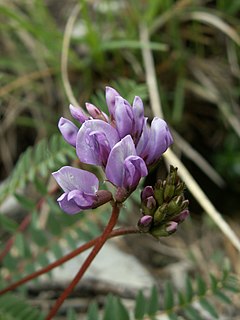
Oxytropis is a genus of plants in the legume family. It is one of three genera of plants known as locoweeds, and are notorious for being toxic to grazing animals. The other locoweed genus is the closely related Astragalus. There are about 300 species, native to Eurasia and North America. Several species are native to the Arctic. These are hairy perennial plants which produce raceme inflorescences of pink, purple, white, or yellow flowers which are generally pea-like but have distinctive sharply beaked keels. The plant produces legume pods containing the seeds.

Asclepias speciosa is a milky-sapped perennial plant in the dogbane family (Apocynaceae), known commonly as the showy milkweed, and is found in the Western half of North America.
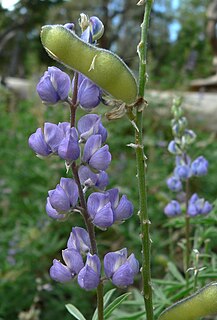
Lupinus argenteus is a species of lupine known by the common name silvery lupine. It is native to much of western North America from the southwestern Canadian provinces to the southwestern and midwestern United States, where it grows in several types of habitat, including sagebrush, grassland, and forests. This is a perennial herb growing erect to heights anywhere between 10 centimetres (3.9 in) and 1.5 metres (4.9 ft). It is sometimes silvery-hairy in texture and sometimes nearly hairless. Each palmate leaf is made up of 5 to 9 leaflets each up to 6 centimetres long. They are narrow and linear in shape, under a centimetre wide. The inflorescence bears many flowers, sometimes arranged in whorls. The flower is 5 millimetres (0.20 in) to 14 millimetres (0.55 in) long and purple, blue, or whitish in color. The banner, or upper petal, of the flower may have a patch of white or yellow. The fruit is a hairy legume pod up to 3 centimeters long containing several beanlike seeds.

Dalea purpurea is a species of flowering plant in the legume family known as purple prairie clover. Native to central north America, purple prairie clover is a relatively common member of the Great Plains and prairie ecosystems. It blooms in the summer with dense spikes of bright purple flowers that attract many species of insects.
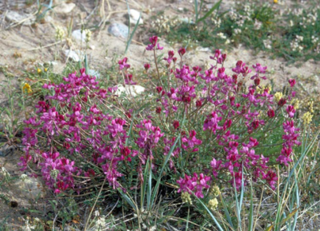
Hedysarum alpinum is a species of flowering plant in the legume family known by the common name alpine sweetvetch. Called “masu” in Alaska Native Inupiaq language. It has a circumpolar distribution, occurring throughout the northern latitudes of the Northern Hemisphere. In North America it is widespread in Canada and the northernmost United States, including Alaska.

Nolina microcarpa is a species of flowering plant in the asparagus family known by the common names sacahuista and palmilla. Like other species of Nolina, it may be called beargrass. It is native to northern Mexico and the southwestern United States in Arizona and New Mexico. It does occur in the southwestern corner of Utah, where it has a limited distribution on Navajo Sandstone, but reports of it occurring in Texas may be in error.
Oxytropis podocarpa is a species of flowering plant in the legume family known by the common names stalkpod locoweed, stalked-pod crazyweed, and Gray's point-vetch. It is native to North America, where it occurs in the northern latitudes, from Yukon and British Columbia across the low arctic to northern Quebec and Labrador. In the Rocky Mountains it occurs at the higher elevations as far south as Colorado.
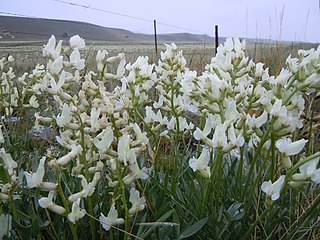
Oxytropis sericea is a species of flowering plant in the legume family known by the common names white locoweed, white point-vetch, whitepoint crazyweed, and silky crazyweed. It is native to western North America from Yukon and British Columbia south through the Pacific Northwest, the Rocky Mountains, and the Great Plains.

Hedysarum boreale is a species of flowering plant in the Fabaceae, or legume family, and is known by the common names Utah sweetvetch, boreal sweet-vetch, northern sweetvetch, and plains sweet-broom. It is native to North America, where it is widespread in northern and western regions of Canada and the United States. The ssp. mackenzii can even be found in the Canadian Arctic Archipelago.

Lupinus arcticus is a species of flowering plant in the legume family known by the common names Arctic lupine or subalpine lupine. It is native to northwestern North America, where it occurs from Oregon north to Alaska and east to Nunavut. It is a common wildflower in British Columbia.
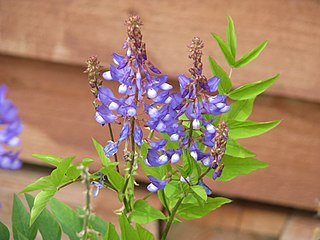
Galega orientalis is a species of flowering plant in the Fabaceae, the legume family. It is known commonly as fodder galega and eastern galega. It is cultivated as a fodder and forage for livestock.

Astragalus drummondii is a species of flowering plant in the legume family known by the common name Drummond's milkvetch. The botanist Thomas Drummond first identified the plant during his travels in North America from 1825 to 1835, the year of his death. Accordingly, A. drummondii, amongst many other plants, was named after the late botanist. Upon the return of samples collected by Drummond to England, his findings were published in Sir William Hooker’s Flora Boreali-Americana in 1840.

Astragalus mollissimus is a perennial plant in the legume family (Fabaceae) found in the Colorado Plateau and Canyonlands region of the southwestern United States.

Astragalus danicus, known as purple milk-vetch, is a species of flowering plant in the family Fabaceae (legumes), which is native to Europe.
















